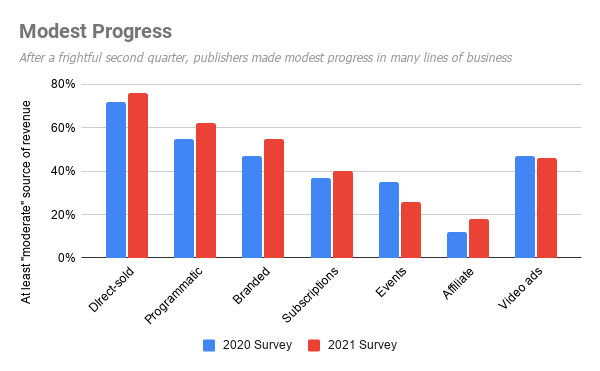Media Briefing: How the media business did — and didn’t — change in 2021
By Tim Peterson
In this week’s Media Briefing, Digiday’s media team recaps the changes that did and did not come to pass in 2021.
- The year in review
- The Washington Post’s woes, Google’s News Showcase struggles and more
- There will be no Media Briefing sent out next week, so stay tuned for a look at the top topics set to shape our coverage in 2022 in the Jan. 6 edition. Happy holidays!
The year in review
The key hits:
- Publishers’ emerging revenue streams remain works in progress.
- Media companies did not make full-fledged returns to the office.
- The shift away from the third-party cookie was delayed.
- Media companies scaled up, but not to the level that may have been expected.
After a year of unprecedented change for the media industry — and the entire world — 2021 was a year of relative stasis. Publishers’ workplaces remained largely remote, as did their events businesses. And while they continued to built up revenue streams to offset their reliance on advertising, those sources remained largely supplementary and suffered some setbacks.
Even the changes that did come in 2021 were more incremental than monumental. A major overhaul set in motion prior to the pandemic — the deprecation of the third-party cookie in Google’s Chrome browser by next month — was pushed back by two years. And while there have been some significant changes with media companies combining and going public, the impacts of those changes will not manifest until 2022 at the earliest.
How publishers worked to diversify their revenue in 2021
Advertising and consumer revenue streams remain pillars in the digital media space, but a lot of effort has taken place in the past year to make the consumer revenue piece more interesting and find new ways of generating money from readers. However, those emerging revenue streams also ran into headwinds in 2021.
Last year in the affiliate commerce space, we saw an inordinate number of publisher marketplaces crop up. In 2021, however, there has been a major shift to include more editorial voice in product reviews and ensuring that those marketplaces were not competing with a grid of products in the same vein as Amazon. Then as the year wore on, even more innovation took place to make online shopping more of an experience, like BuzzFeed devoting more effort into livestream shopping, and Complex Networks testing virtual product drops and a gamified shopping experience during its virtual convention ComplexLand. But, at the same time as BuzzFeed was further building up its commerce business — including by acquiring Complex Networks — its commerce revenue growth slowed in the second half of the year as supply chain challenges put a crimp in the business.
As for subscriptions, publishers saw a bit of a slow down when it comes to traffic and therefore subscriptions, something The Atlantic is now facing and trying to sustain the 50% growth it saw year-over-year from the first half of 2020 to the same period in 2021. The publishers that are combating this slump are focusing …read more
Source:: Digiday





